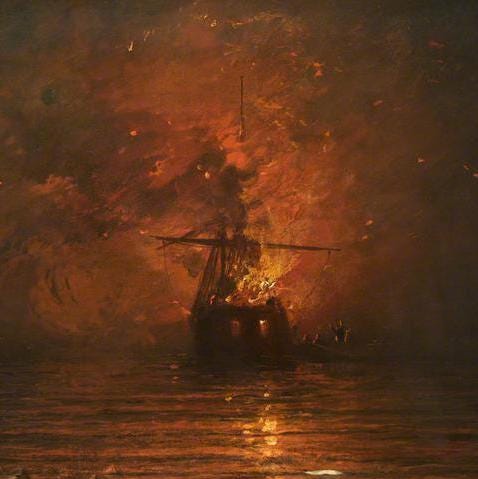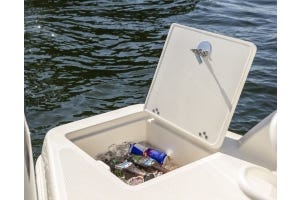The Ghostly Palatine Light


It's late October. The leaves are falling and darkness comes early. It's the perfect time to bundle up and gather around a bonfire on the beach to swap ghost stories. There are many nautical spine-tingling tales, but here's our most recent favorite: the ghostly Palatine Light of Block Island.
In August 1738, British cargo ship Princess Augusta left Rotterdam bound for Philadelphia. Besides Captain George Long and a crew of fourteen, the ship carried 340 immigrants from The Palatinate, a region in what is now southwestern Germany.

Almost from the beginning, the voyage seemed cursed. A terrible sickness, blamed on contaminated drinking water, swept through the ship, killing half the crew and about 200 of the migrants. Captain Long also perished, leaving less experienced first mate Andrew Brook in charge of the ship. Autumn storms battered the ship and blew her off course. As the voyage dragged on and the crew fought to get the ship back on course for the Colonies, food began to run low. According to crew depositions discovered in 1925, Brook demanded payment from the Palatines for their scanty rations. As the weakened migrants starved to death, their bodies were committed to the sea – a polite way of saying they were thrown overboard.
In mid-December, the crew battled a northwest gale as they tried to steer for shore. When the ship threatened to break apart under the strength of the wind, the crew cut free the mizzenmast. Two days after Christmas, in a raging snowstorm, Brook ran the ship aground at Sandy Point on Block Island. The crew testified that Brook took them ashore but would not permit the passengers to leave the ship, abandoning them to the brutal weather and the ruthless sea. The people of Block Island helped the passengers leave the ship with their possessions, and even took them into their own homes until the Palatines regained their health and strength. Princess Augusta was then pushed to deeper water and burned. No trace of the wreck has ever been found.
About twenty more migrants died after the wreck and were buried on the island. As for the survivors, almost all reached the mainland. Two of the immigrants, perhaps dreading to board another ship, decided to settle on Block Island. A marker, erected in 1947 on Block Island, reads simply “Palatine Graves.”

As sad as the story of Princess Augusta is, there exists an even darker version. As told to poet John Greenleaf Whittier, the ship was not the victim of bad luck but of “wreckers,” criminals who lured ships with false lights in order to plunder them after they crashed onto rocks or ran aground. According to this version, once the wreckers had succeeded in getting the ship to run aground, they swarmed over the ship and killed everyone aboard before looting the vessel. Whittier turned this grim tale into his 1867 poem “The Wreck of the Palatine.” Two stanzas imagine the confrontation between the pitiful Palatine migrants and the greedy, murderous wreckers:
O men and brothers! what sights were there!
White upturned faces, hands stretched in prayer!
Where waves had pity, could ye not spare?
Down swooped the wreckers, like birds of prey
Tearing the heart of the ship away,
And the dead had never a word to say.
Naturally, the people of Block Island took exception to this characterization of their ancestors, and local historians have worked ever since to counter Whittier’s portrayal.
However completely Princess Augusta’s remains have vanished, it seems her final, fiery demise lives on. The first written account of a flaming apparition off Block Island comes from 1811 and is collected in a book called History of the State of Rhode Island and Providence Plantations. In a letter to a New York doctor, islander Dr. Aaron C. Willey wrote that he had seen the “Palatine light” with his own eyes, and that it appeared so frequently that the islanders had ceased to find it remarkable. Dr. Willey dismissed those who believed the Palatine light to be the ghost of Princess Augusta as “ignorant and superstitious,” and felt sure there was a scientific reason for the phenomenon. Those with Puritan roots who believed the Whittier version of the story thought that “the Almighty” sent the frightening apparition to remind the islanders of the wreckers’ cruelty to the Palatine immigrants. Most people seem to regard the ghost ship as a bad omen, as the closing lines of Whittier's poem describe:
For still, on many a moonless night,
From Kingston Head and from Montauk light
The spectre kindles and burns in sight.
Now low and dim, now clear and higher,
Leaps up the terrible Ghost of Fire,
Then, slowly sinking, the flames expire.
And the wise Sound skippers, though skies be fine,
Reef their sails when they see the sign
Of the blazing wreck of the Palatine!






